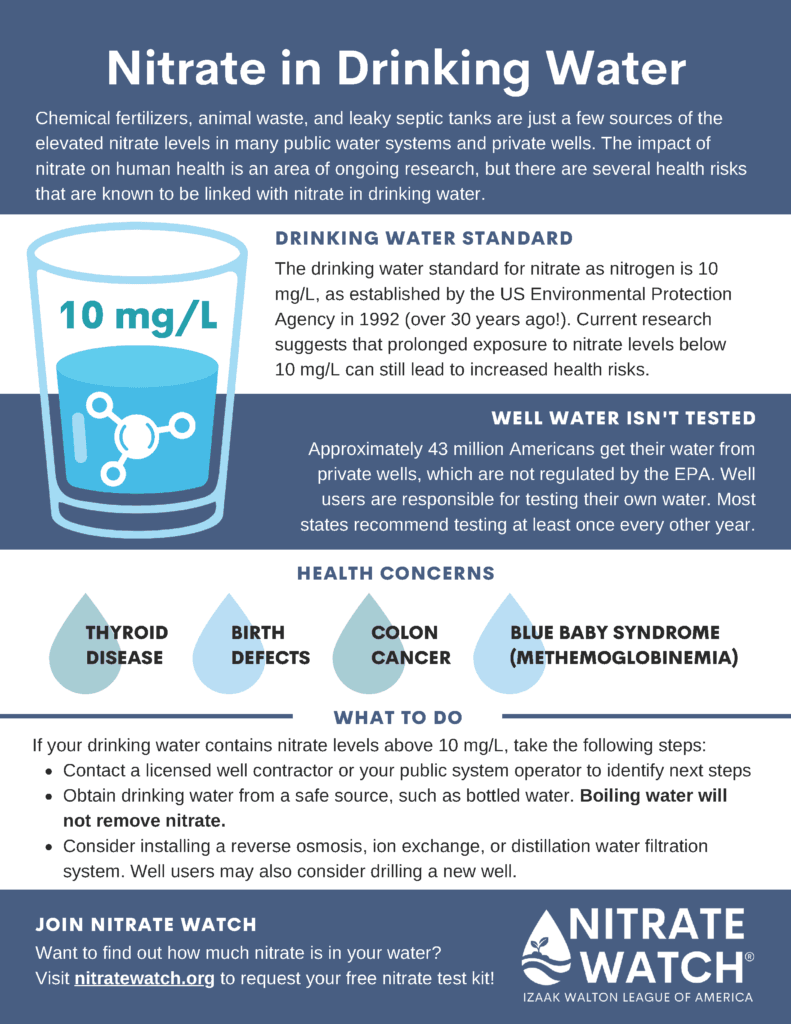Nitrate Watch

Nitrate Watch
Wisconsin's Green Fire is a proud Nitrate Watch partner with Izaak Walton League of America. Pollution from nitrogen negatively impacts both our environment and human health.
Our goal is to engage and empower WGF members in collecting information about water quality in their own communities around Wisconsin. Together, we can advocate for clean water and advance science-based resource protection.
You can join us in better understanding nitrate levels in waters around Wisconsin! We have 70+ community science volunteers like you collecting data all over Wisconsin. Click here to sign up and scroll for more information.
What is Nitrate Watch?
Nitrate Watch is a crowd-sourced community science project of the Izaak Walton League of America. This program mobilizes volunteers across the country to monitor nitrate levels in surface water (rivers, lakes, streams) and drinking water. The goals of Nitrate Watch are to raise awareness about the impacts of nitrate on the environment and human health, identify hotspots of nitrate pollution, and advocate for solutions that reduce nutrient pollution.
Nitrate (NO3--N) is a naturally occurring nitrogen compound and an essential nutrient for plant growth. Unfortunately, human activities produce more nitrogen than natural systems can use. Water containing excess nitrate from sources like fertilizers, manure, and sewage can pose serious problems for the health of humans and the environment.
Get Involved and Test Your Own Water
Anyone can sign up to receive a kit of 25 strips to test their own or their neighbors’ private wells, their city water supply, or any lake, stream or river they care about. These kits are completely free of charge. Once you run out of test strips, simply sign up for more!
>> Click here to fill out the form and get your free Nitrate Watch test kit of 25 water sample strips.
- Testing is easy and quick. View a short how-to video about testing your water sample here.
- List Wisconsin’s Green Fire as your organization when you sign up so we can summarize the data from all around the state.
- Visit https://iwla.org/nitrate-watch/ for additional information on water testing kits.
Do you have questions about participating?
WGF's pro-bono technical experts Christine Mechenich and Paul La Liberte are helping to lead this program alongside WGF staff. If you have questions about participating, please ask!
- Reach Christine Mechenich at cmechenich@wigreenfire.org.
- Reach Paul LaLiberte at plaliberte@wigreenfire.org.
Remember "All Data is Good Data," including test results of zero! Make sure you enter your data on the Clean Water Hub (scroll for more details).
Are you looking for more specific instructions or ideas on how often or where you should do your water testing?
Monthly testing is a great goal, but there is no specific time requirement. Do what works for you as a participant! Repeated sampling at the same sites over time helps us observe patterns in the results.
For locations, you can sample drinking water sources like your own kitchen tap (if you have a private well). You can also sample surface water like a local stream or lake. Or both!
If you have are sampling from a home with a public water supply, you could compare your monthly test results to the annual Consumer Confidence Report nitrate data supplied by your public water utility, or contact the utility for more information on sampling in your neighborhood.
Click here for more details (PDF: "When Should I Do Nitrate Watch Sampling?").
Thank you for helping us use community-science to monitor Wisconsin's waters. Together, we can help protect our water quality through science!
For general questions about Wisconsin's Green Fire, contact us here.
Clean Water Hub
When a volunteer collects their water sample data, they enter it into the Clean Water Hub database.
- When you first sign up, make sure to list Wisconsin's Green Fire as your organization name.
- Doing so helps us keep all the data organized. That way, we can get the most accurate picture of our collective results!
Using the Clean Water Hub, you can view data from Nitrate Watch sites around the United States. According to IWLA, it is "a collaborative tool to help people just like you track water quality in local streams, lakes, and even drinking water. It’s a place to share your local data results so that we can make an impact. The Clean Water Hub enables you to play an active role in the act of conserving, monitoring, and restoring the quality of our nation’s streams and rivers."
Nitrate in Drinking Water
View the factsheet below for more information about nitrate in drinking water. The current drinking water standard is 10 milligrams per liter (mg/L) or 10 parts per million (ppm). Note the serious health concerns for people like thyroid disease, birth defects, colon cancer, and blue baby syndrome (methemoglobinemia). You can find even more factsheets and resources from Nitrate Watch here.


